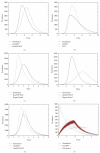Networks and the epidemiology of infectious disease
- PMID: 21437001
- PMCID: PMC3062985
- DOI: 10.1155/2011/284909
Networks and the epidemiology of infectious disease
Abstract
The science of networks has revolutionised research into the dynamics of interacting elements. It could be argued that epidemiology in particular has embraced the potential of network theory more than any other discipline. Here we review the growing body of research concerning the spread of infectious diseases on networks, focusing on the interplay between network theory and epidemiology. The review is split into four main sections, which examine: the types of network relevant to epidemiology; the multitude of ways these networks can be characterised; the statistical methods that can be applied to infer the epidemiological parameters on a realised network; and finally simulation and analytical methods to determine epidemic dynamics on a given network. Given the breadth of areas covered and the ever-expanding number of publications, a comprehensive review of all work is impossible. Instead, we provide a personalised overview into the areas of network epidemiology that have seen the greatest progress in recent years or have the greatest potential to provide novel insights. As such, considerable importance is placed on analytical approaches and statistical methods which are both rapidly expanding fields. Throughout this review we restrict our attention to epidemiological issues.
Figures



References
-
- Klovdahl AS. Social networks and the spread of infectious diseases: the AIDS example. Social Science and Medicine. 1985;21(11):1203–1216. - PubMed
-
- May RM, Anderson RM. Transmission dynamics of HIV infection. Nature. 1987;326(6109):137–142. - PubMed
-
- Bell DC, Atkinson JS, Carlson JW. Centrality measures for disease transmission networks. Social Networks. 1999;21(1):1–21.
-
- Goodman HL. Snowball sampling. Annals of Mathematical Statistics. 1961;32:148–170.
-
- Heckathorn DD. Respondent-driven sampling: a new approach to the study of hidden populations. Social Problems. 1997;44(2):174–199.
Grants and funding
LinkOut - more resources
Full Text Sources
Research Materials

